


xxxxxThe leading French composer Claude Debussy, best known today for his piano piece Claire de lune, was a revolutionary in the musical world. Determined to go his own way and create the “unusual”, he discarded the restrictive theories of the past and, by his innovations in harmony, rhythm and tone, paved the way for the modern music of the 20th century in all its genres, including jazz. His mould-breaking style - made up of new harmonies and in a form described as “continuous improvisation” - can be particularly appreciated in his major compositions, his String Quartet in G Minor of 1893, his orchestral work L'Après-midi d'un faune, produced in 1894, and his opera Pelléas et Mélisande, premiered in 1902. A close friend of the painters and poets of his day, his colourful and ephemeral music is often seen as “musical impressionism”, a term he disliked. He might more accurately be termed a “musical symbolist”, his compositions stirring, as they do, the dream-like thoughts and imaginings inspired by the poems of poets like Baudelaire and Verlaine. Among his other major works are his Three Nocturnes of 1899, his orchestral poem La Mer of 1905, and his ballet Jeux, composed in 1912. His many piano pieces included his Double Preludes of 1910 and 1913, and he produced chamber music and a number of songs, some based on poems by Villon, Baudelaire and Mallarmé.
CLAUDE DEBUSSY 1862 - 1918 (Vb, Vc, E7, G5)
Acknowledgements
Debussy: by the French photographer Paul Nadar (1856-1939) – private collection. Moonlight: Riverbank in Moonlight by the French painter Charles-François Daubigny, a member of the Barbizon School (1817-1878), 1875 – private collection. Faune: detail, by the Hungarian painter Pai Szinyei Merse (1845-1920) – Hungarian National Gallery, Budapest. Chou-Chou: date and photographer unknown. Chabrier: by the French painter Édouard Manet (1832-1883), 1880 – Ordrupgaard Museum, Charlottenlund, Copenhagen, Denmark. Massenet: date and artist unknown. Satie: crayon on paper by the French Neo-Impressionist painter Paul Signac (1863-1935), c1886 – Musée d’Orsay, Paris.
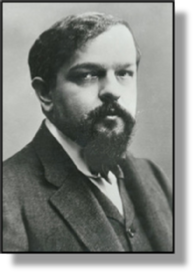
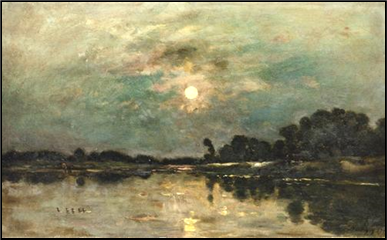 xxxxxClaude Debussy, the greatest French composer of his time, is particularly remembered today for his piano piece Claire de lune (Moonlight) from the Suite Bergamasque of 1890, but his wide-ranging, mould-breaking compositions made him one of the most important musicians of the late 19th and early 20th century. A revolutionary in the development of European music, his innovations in musical harmony, rhythm and tone paved the way for the music of the 20th century, not only in the opera house and the concert hall, but also in the new and exciting world of jazz. His music, full of French clarity, elegance and subtlety, discarded the theoretical restrictions of the past and gave scope for thought and imagination.
xxxxxClaude Debussy, the greatest French composer of his time, is particularly remembered today for his piano piece Claire de lune (Moonlight) from the Suite Bergamasque of 1890, but his wide-ranging, mould-breaking compositions made him one of the most important musicians of the late 19th and early 20th century. A revolutionary in the development of European music, his innovations in musical harmony, rhythm and tone paved the way for the music of the 20th century, not only in the opera house and the concert hall, but also in the new and exciting world of jazz. His music, full of French clarity, elegance and subtlety, discarded the theoretical restrictions of the past and gave scope for thought and imagination.
xxxxxHe was born in Saint-Germain-en-Laye, a few miles west of Paris. The eldest of five children, his father owned a china shop and his mother was a seamstress. As a young boy he showed such talent as a pianist that he was admitted to the Paris Conservatoire at the age of ten. In 1879, however, he failed to win a piano prize and spent the next two years working as a musical tutor to the children of Nadejda von Meck, a patron at that time of the Russian composer Pyotr Tchaikovsky. This took him to Switzerland, Italy and Russia. While in Moscow he met the country’s leading composers, including Tchaikovsky, Alexander Borodin and Modest Mussorgsky, and acquired a love of Russian folk and gypsy music.
xxxxxOn his return, he won the coveted Grand Prix de Rome in 1884 with his cantata The Prodigal Son, but he found nothing to his liking in the Eternal City and became depressed. He found the atmosphere there stifling, and the people boorish. Having had a number of his compositions rejected, including the symphonic suite Printemps and his cantata La Demoiselle élue, based on a work by the English poet Dante Gabriel Rossetti, he left in 1887, determined to go his own way. Reserved and somewhat surly and touchy by nature, he argued that the teaching at the Academy was far too rigid and amounted to slave labour. He wanted his freedom so that he could break away from the restrictions imposed by Western harmony and form, and concentrate on the “unusual”. There was no such thing as theory, one only had to listen. Music was sound for sound’s sake.
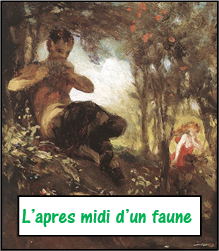 xxxxxTrue to his word, he rejected the Wagnerian currents in the music of his day, regarding the German composer as “a beautiful sunset mistaken for the dawn”. As from the 1890s he introduced radical changes in the treatment of chords, introducing thereby new, unfamiliar forms of melody and harmony. Thus his music led to the break up of scale as used in the 19th century, and became, in essence, an experiment in continuous improvisation, devoid, so it seemed, of any prior thought as to the development of a theme. Music was simply a personal sensation, with inspiration taken from the past or the present, be it from poetry, painting, the love of the Orient, or the art of antiquity. This revolutionary new approach had been hinted at in his La Damoiselle élue of 1888, but it became clearly evident in his String Quartet in G Minor in 1893 (a work which paved the way for his more unorthodox experiments in harmony), and in his first important orchestral work L'Après-midi d'un
xxxxxTrue to his word, he rejected the Wagnerian currents in the music of his day, regarding the German composer as “a beautiful sunset mistaken for the dawn”. As from the 1890s he introduced radical changes in the treatment of chords, introducing thereby new, unfamiliar forms of melody and harmony. Thus his music led to the break up of scale as used in the 19th century, and became, in essence, an experiment in continuous improvisation, devoid, so it seemed, of any prior thought as to the development of a theme. Music was simply a personal sensation, with inspiration taken from the past or the present, be it from poetry, painting, the love of the Orient, or the art of antiquity. This revolutionary new approach had been hinted at in his La Damoiselle élue of 1888, but it became clearly evident in his String Quartet in G Minor in 1893 (a work which paved the way for his more unorthodox experiments in harmony), and in his first important orchestral work L'Après-midi d'un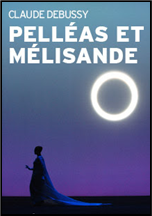 faune, based on the poem of that name by the French poet Stéphane Mallarmé and produced in 1894. Despite their controversial nature, these works eventually brought him recognition as a leading, avant-garde composer of his time. The latter work in particular, a series of variations and repetitions on a basic theme - a highly original format for that time - has remained popular to this day. Then 1902 saw the performance of his only completed opera Pelléas et Mélisande, based on Maeterlinck’s play of that name. Its depiction of mood and its abstract, dreamlike quality introduced a whole new world of modern music, and earned Debussy widespread fame.
faune, based on the poem of that name by the French poet Stéphane Mallarmé and produced in 1894. Despite their controversial nature, these works eventually brought him recognition as a leading, avant-garde composer of his time. The latter work in particular, a series of variations and repetitions on a basic theme - a highly original format for that time - has remained popular to this day. Then 1902 saw the performance of his only completed opera Pelléas et Mélisande, based on Maeterlinck’s play of that name. Its depiction of mood and its abstract, dreamlike quality introduced a whole new world of modern music, and earned Debussy widespread fame.
xxxxxIn style, some regarded his music as akin to impressionism, comparing his works with the paintings of Monet, Renoir and Degas. His new musical form was seen as giving light and colour to a fleeting impression or mood. Debussy certainly knew the leading impressionist painters of the day, and he vigorously maintained that music could not be cast into a fixed form, but was “made up of colours and rhythms”. Nonetheless he did not like the term “musical impressionism” as applied to his compositions. Others saw Debussy as a “musical symbolist”, and perhaps this is a more fitting description. He admired the works of the French symbolist poets Baudelaire, Mallarmé and Verlaine, and he was fascinated with the writings of the American mystery writer Edgar Allan Poe. It could be argued that his compositions stirred the dream-like inner feelings in much the same way as did their poems. Indeed, in 1885 he wrote that he preferred a subject where action was sacrificed to feeling, so that music could become “more human and real”.
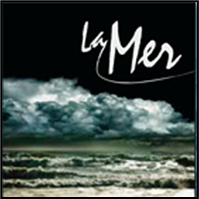 xxxxxAmong his other major works were his Three Nocturnes of 1899 (inspired by the paintings of the American artist James Whistler), his orchestral poem La Mer of 1905, and his ballet Jeux, written for the Ballets Russes in 1912. His many piano pieces included his Trois Estampes (Engravings) of 1903 and his Double Preludes of 1910 and 1912, the unfamiliar harmonies of which were to pave the way for the advent of jazz. Among his pieces of chamber music, likewise significant for their harmonic originality, were sonatas for cello and piano and violin and piano, and his many songs included two sets of Fêtes galantes, three ballades based on texts from the 15th century French poet François Villon, and works based on poems by Baudelaire and Mallarmé.
xxxxxAmong his other major works were his Three Nocturnes of 1899 (inspired by the paintings of the American artist James Whistler), his orchestral poem La Mer of 1905, and his ballet Jeux, written for the Ballets Russes in 1912. His many piano pieces included his Trois Estampes (Engravings) of 1903 and his Double Preludes of 1910 and 1912, the unfamiliar harmonies of which were to pave the way for the advent of jazz. Among his pieces of chamber music, likewise significant for their harmonic originality, were sonatas for cello and piano and violin and piano, and his many songs included two sets of Fêtes galantes, three ballades based on texts from the 15th century French poet François Villon, and works based on poems by Baudelaire and Mallarmé.
xxxxxDebussy was diagnosed with bowel cancer in 1909, and this seriously affected the volume and quality of his composition during the last ten years of his life. He had other works in mind, including an opera based on Poe’s famous story The Fall of the House of Usher, but he lacked the time and energy to complete them. He died in March 1918 during the bombardment of Paris, carried out by long-range German artillery during the closing stages of the First World War.
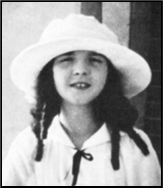 xxxxxIncidentally, Debussy’s private life was somewhat turbulent. For nine years he lived with his mistress Gabrielle Dupont (Gaby), but in 1899 married a dressmaker named Rosalie Texier. Five years later, however, he abandoned her for Emma Bardac, the wife of a Parisian banker. As a consequence Rosalie attempted to commit suicide - shooting herself in the chest while standing in La Place de la Concorde, Paris - and to avoid the scandal he and Emma fled to England. It was while they were living in the Grand Hotel in Eastbourne, Sussex, that he completed his symphonic suite La Mer. In 1905 they had a daughter, Claude-Emma, nicknamed “Chou Chou” (illustrated), and they married three years later. Sadly the little girl died of diphtheria only a year after Debussy’s death.
xxxxxIncidentally, Debussy’s private life was somewhat turbulent. For nine years he lived with his mistress Gabrielle Dupont (Gaby), but in 1899 married a dressmaker named Rosalie Texier. Five years later, however, he abandoned her for Emma Bardac, the wife of a Parisian banker. As a consequence Rosalie attempted to commit suicide - shooting herself in the chest while standing in La Place de la Concorde, Paris - and to avoid the scandal he and Emma fled to England. It was while they were living in the Grand Hotel in Eastbourne, Sussex, that he completed his symphonic suite La Mer. In 1905 they had a daughter, Claude-Emma, nicknamed “Chou Chou” (illustrated), and they married three years later. Sadly the little girl died of diphtheria only a year after Debussy’s death.
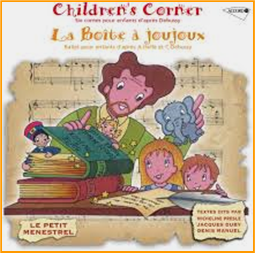 xxxxx……xxIn 1908 he dedicated Children’s Corner, his delightful suite for solo piano, to Chou-Chou. In the sixth and final piece of this work, Gollywog’s Cakewalk, he pokes fun at the German composer Richard Wagner by copying the opening bars of the prelude to his opera Tristan and Isolde, and then concluding it with a musical chuckle. ……
xxxxx……xxIn 1908 he dedicated Children’s Corner, his delightful suite for solo piano, to Chou-Chou. In the sixth and final piece of this work, Gollywog’s Cakewalk, he pokes fun at the German composer Richard Wagner by copying the opening bars of the prelude to his opera Tristan and Isolde, and then concluding it with a musical chuckle. ……
xxxxx……xxA number of other French composers were also making a name for themselves during the closing years of the 19th century. As we have seen, the talented pianist and organist Gabriel Fauré, taught and supported by Saint-Saens, produced his Requiem in 1888, and provided the incidental music for Maeterlinck’s play Pelléas et Mélisande in 1898. In the meantime, Emmanuel Chabrier delighted audiences in the 1880s with his orchestral works España and Joyeuse marche; Émile Waldteufel produced his waltz España in 1886, based on Chabrier’s piece; Jules Massenet produced Manon in 1884, one of the best of his 24 operas; and the colourful character Erik Satie, a friend of Debussy, began to attract attention with his Trois gymnopédies in 1888.
Vc-1881-1901-Vc-1881-1901-Vc-1881-1901-Vc-1881-1901-Vc-1881-1901-Vc-1881-1901-Vc
Including:
Emmanuel Chabrier,
Émile Waldteufel,
Jules Massenet,
and Eric Satie

xxxxxThe Frenchman Emmanuel Chabrier (1841-1894) did not start composing in earnest until the age of 39. His early works, the opera The Star and his operetta An Incomplete Education, were quite well received, but fame came with his lively orchestral piece España, composed after a visit to Spain in 1882. Later works included the comic opera The Reluctant King, and his popular orchestral piece Joyeuse Marche. A talented pianist, he wrote a number of works for the piano, and his Pièces pittoresques of 1880 in particular, by their unconventional rhythms and harmonies, and their lack of development, foreshadowed the revolutionary works of Debussy.
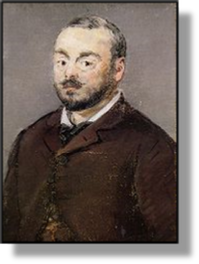 xxxxxThe French composer Emmanuel Chabrier (1841-1894) gained a law degree in 1862 and for the next 18 years worked as a civil servant in the Ministry of the Interior. However, he retained his passion for music and, as a skilled pianist, composed a number of piano pieces during the 1860s. Then in the late 1870s he turned his talent to the stage, producing L’Étoile (The Star), a three act opera, and Une Éducation Manquée (An Incomplete Education), a lively operetta much suited to his style. Both were well received and this, together with a growing admiration for the works of Richard Wagner, convinced him that his future lay as a composer.
xxxxxThe French composer Emmanuel Chabrier (1841-1894) gained a law degree in 1862 and for the next 18 years worked as a civil servant in the Ministry of the Interior. However, he retained his passion for music and, as a skilled pianist, composed a number of piano pieces during the 1860s. Then in the late 1870s he turned his talent to the stage, producing L’Étoile (The Star), a three act opera, and Une Éducation Manquée (An Incomplete Education), a lively operetta much suited to his style. Both were well received and this, together with a growing admiration for the works of Richard Wagner, convinced him that his future lay as a composer.
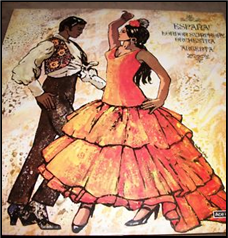 xxxxxIn 1880, at the age of 39, he quit his job at the ministry and produced his piano cycle Pièces pittoresques, ten varied miniatures that, by their unconventional rhythms and harmonies, plus their lack of development, foreshadowed the revolutionary music of Debussy.
xxxxxIn 1880, at the age of 39, he quit his job at the ministry and produced his piano cycle Pièces pittoresques, ten varied miniatures that, by their unconventional rhythms and harmonies, plus their lack of development, foreshadowed the revolutionary music of Debussy.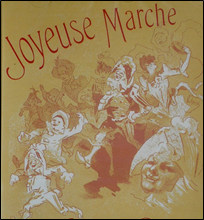 Then, following a visit to Spain in 1882 he produced his famous España, a rhapsody for orchestra that captured in scintillating form the lively rhythms and melodies of a sunny, vibrant land. He once claimed that he was “more temperament than talent”, but in this work he showed an abundance of both. Later works included his light-hearted comic opera Le Roi malgré lui (The Reluctant King) and the extremely popular orchestral piece Joyeuse Marche of 1888, later made into a piano duet. These, like his earlier compositions, were generally light in tone and style.
Then, following a visit to Spain in 1882 he produced his famous España, a rhapsody for orchestra that captured in scintillating form the lively rhythms and melodies of a sunny, vibrant land. He once claimed that he was “more temperament than talent”, but in this work he showed an abundance of both. Later works included his light-hearted comic opera Le Roi malgré lui (The Reluctant King) and the extremely popular orchestral piece Joyeuse Marche of 1888, later made into a piano duet. These, like his earlier compositions, were generally light in tone and style.
xxxxxIn Paris, Chabrier moved freely in musical and artistic circles. He was a friend of the composer Fauré, knew the poet Verlaine, and was on especially good terms with the major artists of his day, particularly the Impressionist painters Renoir, Monet and Manet. (The portrait above is by the last named.) A keen art lover, during his career he bought a large number of Impressionist paintings - one Cezanne, at least two Sisley, six Renoir, eight Monet, and eleven Manet! At the time they were hardly worth anything. Little did he know then what enormous prices they would command in just sixty or seventy years’ time. Today, a number of these works are to be seen in some of the world’s leading art galleries.
xxxxxIncidentally, in 1886 the French composer of dance music, Émile Waldteufel (1837-1915), produced a waltz entitled España, based upon Chabrier’s piece. He studied piano at the Paris Conservatory from 1853 to 1857, where one of his fellow students was the young composer Jules Massenet. At the age of 27 he became court pianist to the Empress Eugénie,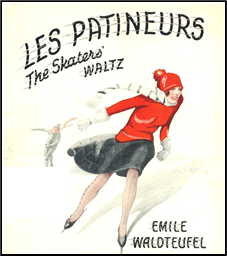 and remained in this post until the Franco-Prussian War of 1870-71 put an end to the Second French Empire.
and remained in this post until the Franco-Prussian War of 1870-71 put an end to the Second French Empire.
xxxxxOn a visit to London in 1874 he played before the Prince of Wales (the future Edward VII) and later his music was played at Buckingham Palace in front of Queen Victoria. It was while in London in 1882 that he composed his best known waltz Les Patineurs (The Ice Skaters). He gave concerts in a number of European capitals during the 1880s and 1890s, and continued to conduct and write dance music until his retirement in 1899.
xxxxxDuring his career he composed some twenty waltzes and a number of polkas. His waltzes have been likened to those of Johann Strauss the Younger, but they were far less robust and earned the title “Hymn-tune waltzes”. Among his works were the waltzes Violettes, Solitude and Coquetterie, and the Rococo Polka.
xxxxxThe French composer Jules Massenet (1842-1912) wrote 24 operas, all designed to meet the public liking for tuneful melodies and a storyline full of drama, pathos and passion. His works, set in exotic and romantic places, and often graced with captivating women, proved highly popular in his time. Among his major productions were Manon and Le Cid in the 1980s, and Werther and Thaïs in the 1890s. He wrote a wealth of music, including overtures, incidental music for plays, ballet music and some 200 songs. Much of his work was noted for its graceful, melodic charm. He is particularly remembered today for his oratorio Marie-Magdeleine, and his intermezzo Meditation from his opera Thaïs. He was professor of composition at the Paris Conservatory from 1878 to 1896.
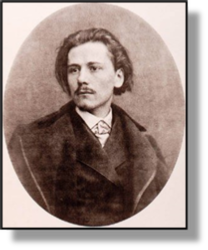 xxxxxJules Massenet (1842-1912) dominated French opera for close on 30 years. His musical career began when he won the Prix de Rome in 1862 with his cantata David Rizzio. He became acquainted with Franz Liszt while in Rome, and on his return, decided to pamper to popular taste. Sensing that there was a craving at large for simple, tuneful melodies and a storyline that gave scope for drama, pathos and passion, he turned his hand to opera. The first of his 24 operas, La Grande Tante, produced in 1867, was not particularly successful, but as he warmed to his task his creations became highly popular and very lucrative.
xxxxxJules Massenet (1842-1912) dominated French opera for close on 30 years. His musical career began when he won the Prix de Rome in 1862 with his cantata David Rizzio. He became acquainted with Franz Liszt while in Rome, and on his return, decided to pamper to popular taste. Sensing that there was a craving at large for simple, tuneful melodies and a storyline that gave scope for drama, pathos and passion, he turned his hand to opera. The first of his 24 operas, La Grande Tante, produced in 1867, was not particularly successful, but as he warmed to his task his creations became highly popular and very lucrative.

xxxxxAmong his major operas, each composed to suit varying tastes, was Le Roi de Lahore of 1877, designed to meet the public liking for the exoticism of the Orient, Le Cid, a grand opera premiered in 1885, and Esclarmonde four years later, a story of medieval chivalry produced in the style of the German composer Richard Wagner. His Manon of 1884, generally considered his masterpiece, was a commendable portrayal of Manon Lescaut, the novel by the French writer Abbé Prévost. Later works of note were Werther, after the work of the German writer Goethe, and Thaïs (based on the novel by Anatole France), an exotic opera set in Egypt which, like many of his others, has a captivating and seductive heroine.
xxxxxApart from operas, Massenet also composed overtures, incidental music for plays, ballet music, oratorios and cantatas, a piano concerto and some two hundred songs. Much of his work is noted for its graceful, melodic charm. Particularly remembered today are his oratorio Marie-Magdeleine (praised amongst others by Tchaikovsky and Gounod) and his intermezzo Meditation from his opera Thaïs. An earlier work, an elegy for cello and orchestra entitled Les Erinnyes (The Furies), - incidental music to the play of that name by Leconte de Lisle - was particularly popular during the last decade of the century. Massenet was professor of composition at the Paris Conservatory from 1878 to 1896.
xxxxxThe eccentric pianist and composer Erik Satie (1866-1925), a close friend of Claude Debussy, is best known today for his group of piano pieces entitled Trois Gymopedies and Trois Gnossiennes, both of the late 1880s. His music, which lacked any form of development and included ballet and works for the theatre, was mainly subdued in tone, but had a strange, haunting quality. Having failed at the Paris Conservatory, for some years he played the piano at a Montmartre cabaret, and enjoyed a bohemian life style. In 1905, however, he returned to his musical studies, and his work became more serious. His early works included his ballet Jack-in-the Box, and piano pieces with odd titles such as Three pieces in the form of a pear and Three genuine flabby preludes! Notable in his later compositions were a series of humorous piano pieces, music for the ballet Parade, premiered in 1917, and his inspiring cantata Socrate. He was in the forefront of musical change at the turn of the century, and it is in the innovative nature of his music that his importance mainly lies.
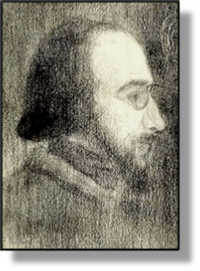 xxxxxThe colourful, eccentric character Erik Satie (1866-1925), a close friend of Claude Debussy, was a French pianist and composer best remembered today for his Trois Gymnopédies of 1888 and his Trois Gnossiennes of 1890, novel groups of piano pieces which, like much of his work, are subdued and solemn in tone, but have a haunting, strangely beautiful quality. In these and later pieces he rejected the idea of a “musical development”, and this added to the interest and innovative nature of his compositions.
xxxxxThe colourful, eccentric character Erik Satie (1866-1925), a close friend of Claude Debussy, was a French pianist and composer best remembered today for his Trois Gymnopédies of 1888 and his Trois Gnossiennes of 1890, novel groups of piano pieces which, like much of his work, are subdued and solemn in tone, but have a haunting, strangely beautiful quality. In these and later pieces he rejected the idea of a “musical development”, and this added to the interest and innovative nature of his compositions.
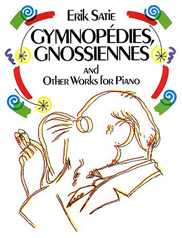 xxxxxBorn in Honfleur, Normandy, he was assessed as “untalented” during his studies at the Paris Conservatory, and by the late 1880s he was reduced to playing the piano in Le Chat Noir, a cabaret in Montmartre, adapting pieces of popular music for piano and piano and voice. His own compositions at this period - none published at the time - were the ballet Jack-in-the-Box, written for a pantomime, a short comic opera Geneviève de Brabant, and a piece of music entitled The Dreamy Fish. Other works with amusing, off-beat titles were Three pieces in the form of a pear (after his work was criticised for having no form!), and later, Three dried-up embryos and Three genuine flabby preludes! In these early years he tended to write his scores in red ink and accompany them with terse, witty instructions such as “light as an egg”, “muffle the sound”, and “work it out for yourself”!
xxxxxBorn in Honfleur, Normandy, he was assessed as “untalented” during his studies at the Paris Conservatory, and by the late 1880s he was reduced to playing the piano in Le Chat Noir, a cabaret in Montmartre, adapting pieces of popular music for piano and piano and voice. His own compositions at this period - none published at the time - were the ballet Jack-in-the-Box, written for a pantomime, a short comic opera Geneviève de Brabant, and a piece of music entitled The Dreamy Fish. Other works with amusing, off-beat titles were Three pieces in the form of a pear (after his work was criticised for having no form!), and later, Three dried-up embryos and Three genuine flabby preludes! In these early years he tended to write his scores in red ink and accompany them with terse, witty instructions such as “light as an egg”, “muffle the sound”, and “work it out for yourself”!
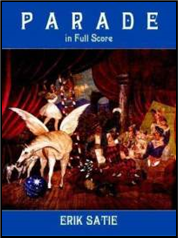 xxxxxIn 1905, however, he abandoned his bohemian life style and for the next five years went back to school to study classical counterpoint. He then turned to more serious compositions and from 1912 onwards produced a highly successful series of humorous melodies for the piano. In the meantime he worked on incidental music for a production of Shakespeare’s A Midsummer Night’s Dream, and in 1915 wrote the score for Parade, a ballet composed by the writer and film director Jean Cocteau. Premiered in 1917, its odd sound effects - such as pistol shots, a foghorn, and the clatter of a typewriter - placed it firmly in the realm of “surrealism”, an artistic movement yet to come but here on the move. Also notable in this period was his inspiring cantata Socrate, and three small pieces known as his “Furniture music”. For a time he was a member of Les Six, a group of avant-garde French composers who were opposed to impressionism on the one hand, and Wagnerian romanticism on the other.
xxxxxIn 1905, however, he abandoned his bohemian life style and for the next five years went back to school to study classical counterpoint. He then turned to more serious compositions and from 1912 onwards produced a highly successful series of humorous melodies for the piano. In the meantime he worked on incidental music for a production of Shakespeare’s A Midsummer Night’s Dream, and in 1915 wrote the score for Parade, a ballet composed by the writer and film director Jean Cocteau. Premiered in 1917, its odd sound effects - such as pistol shots, a foghorn, and the clatter of a typewriter - placed it firmly in the realm of “surrealism”, an artistic movement yet to come but here on the move. Also notable in this period was his inspiring cantata Socrate, and three small pieces known as his “Furniture music”. For a time he was a member of Les Six, a group of avant-garde French composers who were opposed to impressionism on the one hand, and Wagnerian romanticism on the other.
 xxxxxOutside of music he lived a somewhat bizarre life, particularly in his early years. In 1893, for example, he founded his own religious order and, as its sole member, served as the high priest. At one time he took to wearing velvet suits, began collecting umbrellas, and put up for sale small buildings which, in fact, only existed in his imagination! Later in his career he became a member of a radical socialist party. (The illustration is a self-portrait, date unknown.)
xxxxxOutside of music he lived a somewhat bizarre life, particularly in his early years. In 1893, for example, he founded his own religious order and, as its sole member, served as the high priest. At one time he took to wearing velvet suits, began collecting umbrellas, and put up for sale small buildings which, in fact, only existed in his imagination! Later in his career he became a member of a radical socialist party. (The illustration is a self-portrait, date unknown.)
xxxxxIn his piano pieces and his music for theatre and ballet, Satie was in the forefront of musical change, and it is in the innovative nature of his music that his importance mainly lies. A heavy drinker throughout his life, he eventually developed cirrhosis of the liver and died of this complaint in July 1925. His room in Arcueil, a suburb of Paris, was found to contain a large number of unpublished compositions for both piano and stage.







 xxxxxClaude Debussy, the greatest French composer of his time, is particularly remembered today for his piano piece Claire de lune (Moonlight) from the Suite Bergamasque of 1890, but his wide-
xxxxxClaude Debussy, the greatest French composer of his time, is particularly remembered today for his piano piece Claire de lune (Moonlight) from the Suite Bergamasque of 1890, but his wide- xxxxxTrue to his word, he rejected the Wagnerian currents in the music of his day, regarding the German composer as “a beautiful sunset mistaken for the dawn”. As from the 1890s he introduced radical changes in the treatment of chords, introducing thereby new, unfamiliar forms of melody and harmony. Thus his music led to the break up of scale as used in the 19th century, and became, in essence, an experiment in continuous improvisation, devoid, so it seemed, of any prior thought as to the development of a theme. Music was simply a personal sensation, with inspiration taken from the past or the present, be it from poetry, painting, the love of the Orient, or the art of antiquity. This revolutionary new approach had been hinted at in his La Damoiselle élue of 1888, but it became clearly evident in his String Quartet in G Minor in 1893 (a work which paved the way for his more unorthodox experiments in harmony), and in his first important orchestral work L'Après-
xxxxxTrue to his word, he rejected the Wagnerian currents in the music of his day, regarding the German composer as “a beautiful sunset mistaken for the dawn”. As from the 1890s he introduced radical changes in the treatment of chords, introducing thereby new, unfamiliar forms of melody and harmony. Thus his music led to the break up of scale as used in the 19th century, and became, in essence, an experiment in continuous improvisation, devoid, so it seemed, of any prior thought as to the development of a theme. Music was simply a personal sensation, with inspiration taken from the past or the present, be it from poetry, painting, the love of the Orient, or the art of antiquity. This revolutionary new approach had been hinted at in his La Damoiselle élue of 1888, but it became clearly evident in his String Quartet in G Minor in 1893 (a work which paved the way for his more unorthodox experiments in harmony), and in his first important orchestral work L'Après- faune
faune xxxxxAmong his other major works were his Three Nocturnes of 1899 (inspired by the paintings of the American artist James Whistler), his orchestral poem La Mer of 1905, and his ballet Jeux, written for the Ballets Russes in 1912. His many piano pieces included his Trois Estampes (Engravings) of 1903 and his Double Preludes of 1910 and 1912, the unfamiliar harmonies of which were to pave the way for the advent of jazz. Among his pieces of chamber music, likewise significant for their harmonic originality, were sonatas for cello and piano and violin and piano, and his many songs included two sets of Fêtes galantes, three ballades based on texts from the 15th century French poet François Villon, and works based on poems by Baudelaire and Mallarmé.
xxxxxAmong his other major works were his Three Nocturnes of 1899 (inspired by the paintings of the American artist James Whistler), his orchestral poem La Mer of 1905, and his ballet Jeux, written for the Ballets Russes in 1912. His many piano pieces included his Trois Estampes (Engravings) of 1903 and his Double Preludes of 1910 and 1912, the unfamiliar harmonies of which were to pave the way for the advent of jazz. Among his pieces of chamber music, likewise significant for their harmonic originality, were sonatas for cello and piano and violin and piano, and his many songs included two sets of Fêtes galantes, three ballades based on texts from the 15th century French poet François Villon, and works based on poems by Baudelaire and Mallarmé. xxxxxIncidentally, Debussy’s private life was somewhat turbulent. For nine years he lived with his mistress Gabrielle Dupont (Gaby), but in 1899 married a dressmaker named Rosalie Texier. Five years later, however, he abandoned her for Emma Bardac, the wife of a Parisian banker. As a consequence Rosalie attempted to commit suicide -
xxxxxIncidentally, Debussy’s private life was somewhat turbulent. For nine years he lived with his mistress Gabrielle Dupont (Gaby), but in 1899 married a dressmaker named Rosalie Texier. Five years later, however, he abandoned her for Emma Bardac, the wife of a Parisian banker. As a consequence Rosalie attempted to commit suicide - xxxxx……xxIn 1908 he dedicated Children’s Corner, his delightful suite for solo piano, to Chou-
xxxxx……xxIn 1908 he dedicated Children’s Corner, his delightful suite for solo piano, to Chou-
 xxxxxThe French composer Emmanuel Chabrier (1841-
xxxxxThe French composer Emmanuel Chabrier (1841- xxxxxIn 1880, at the age of 39, he quit his job at the ministry and produced his piano cycle Pièces pittoresques, ten varied miniatures that, by their unconventional rhythms and harmonies, plus their lack of development, foreshadowed the revolutionary music of Debussy.
xxxxxIn 1880, at the age of 39, he quit his job at the ministry and produced his piano cycle Pièces pittoresques, ten varied miniatures that, by their unconventional rhythms and harmonies, plus their lack of development, foreshadowed the revolutionary music of Debussy. Then, following a visit to Spain in 1882 he produced his famous España, a rhapsody for orchestra that captured in scintillating form the lively rhythms and melodies of a sunny, vibrant land. He once claimed that he was “more temperament than talent”, but in this work he showed an abundance of both. Later works included his light-
Then, following a visit to Spain in 1882 he produced his famous España, a rhapsody for orchestra that captured in scintillating form the lively rhythms and melodies of a sunny, vibrant land. He once claimed that he was “more temperament than talent”, but in this work he showed an abundance of both. Later works included his light- and remained in this post until the Franco-
and remained in this post until the Franco- xxxxxJules Massenet (1842-
xxxxxJules Massenet (1842-
 xxxxxThe colourful, eccentric character Erik Satie (1866-
xxxxxThe colourful, eccentric character Erik Satie (1866- xxxxxBorn in Honfleur, Normandy, he was assessed as “untalented” during his studies at the Paris Conservatory, and by the late 1880s he was reduced to playing the piano in Le Chat Noir, a cabaret in Montmartre, adapting pieces of popular music for piano and piano and voice. His own compositions at this period -
xxxxxBorn in Honfleur, Normandy, he was assessed as “untalented” during his studies at the Paris Conservatory, and by the late 1880s he was reduced to playing the piano in Le Chat Noir, a cabaret in Montmartre, adapting pieces of popular music for piano and piano and voice. His own compositions at this period - xxxxxIn 1905, however, he abandoned his bohemian life style and for the next five years went back to school to study classical counterpoint. He then turned to more serious compositions and from 1912 onwards produced a highly successful series of humorous melodies for the piano. In the meantime he worked on incidental music for a production of Shakespeare’s A Midsummer Night’s Dream, and in 1915 wrote the score for Parade, a ballet composed by the writer and film director Jean Cocteau. Premiered in 1917, its odd sound effects -
xxxxxIn 1905, however, he abandoned his bohemian life style and for the next five years went back to school to study classical counterpoint. He then turned to more serious compositions and from 1912 onwards produced a highly successful series of humorous melodies for the piano. In the meantime he worked on incidental music for a production of Shakespeare’s A Midsummer Night’s Dream, and in 1915 wrote the score for Parade, a ballet composed by the writer and film director Jean Cocteau. Premiered in 1917, its odd sound effects - xxxxxOutside of music he lived a somewhat bizarre life, particularly in his early years. In 1893, for example, he founded his own religious order and, as its sole member, served as the high priest. At one time he took to wearing velvet suits, began collecting umbrellas, and put up for sale small buildings which, in fact, only existed in his imagination! Later in his career he became a member of a radical socialist party. (The illustration is a self-
xxxxxOutside of music he lived a somewhat bizarre life, particularly in his early years. In 1893, for example, he founded his own religious order and, as its sole member, served as the high priest. At one time he took to wearing velvet suits, began collecting umbrellas, and put up for sale small buildings which, in fact, only existed in his imagination! Later in his career he became a member of a radical socialist party. (The illustration is a self-

